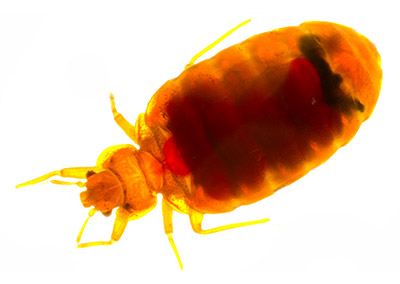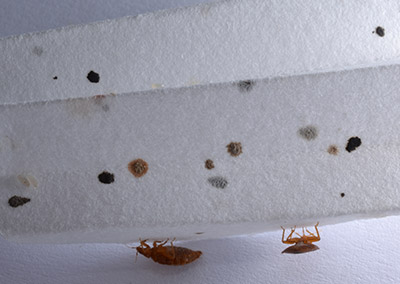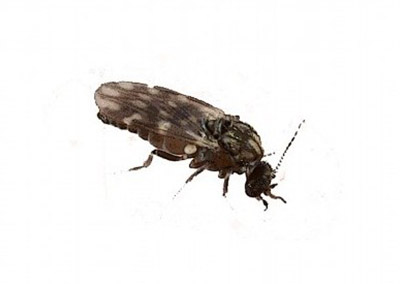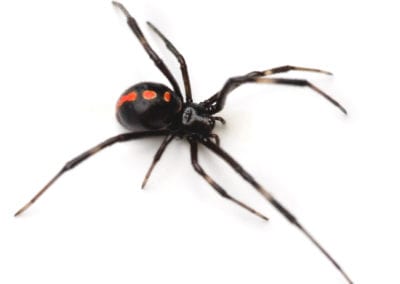Bed Bug
Our remedy for bed bug control
First, contact us. We understand what you’re going through and will make it our priority to get you back to sleeping soundly.
Bed bugs were a problem decades ago when DDT was underneath everyone’s household kitchen sink. This many years later, bed bugs have made a comeback. They are much more resilient due to adaptation to the overuse of such chemicals, but also because the types of pest control products available today are not as deadly and much more conscious of our health concerns.
Bed bugs are effectively controlled today with the right partnership and intelligent strategies. Conventional products and cautious monitoring are very successful when done right. Bed bugs are NOT a DIY pest and if you think you might have them, contacting a professional sooner rather than later for expert bed bug solutions will help gain control of a problem quicker.

How to Identify a Bed Bug
Appearance
Depending on life cycle stage, bed bugs can range from translucent yellowish (newly hatched) to rusty brown (adult stages) and even bright red after a blood meal. Unfed, bed bugs are flat and oval, yellow to golden brown with a dark squiggle on their abdomen (that’s their digestive system). After a blood meal, they’re plump and reddish brown (because they’re filled with blood).
Habitat
As their name implies, bed bugs like to live and feed in beds, where you spend a long amount of time at rest, so they can take advantage of you, their food source. They also live behind baseboards, wallpaper, picture frames, drapery folds, upholstery, in pet beds, and in furniture crevices. They are transferred from one place to the next by hitchhiking in or on suitcases, boxes, purses and shoes. Elusive and nocturnal, they make their presence known most often through the red, itchy bites they leave behind. At this time, they have not been known to transmit diseases.
Diet
Blood; primarily human, but bed bugs will dine on any warm-blooded animal.
Additional Imagery
Is This Your Critter?
Maybe it is, maybe it isn’t. We can handle the identification and get you a solution to your problem quickly.
Get a remedy now. Send a message!
Bed Bugs FAQs
What Are Bed Bugs?
Bed bugs, those infamous tiny brownish-red insects, are notorious for making homes in beds and feasting on human blood while they sleep. With a history spanning over 3,300 years intertwined with humans, they’ve established a presence in nearly every communal space humans frequent, from homes to hotels, schools to offices, and even public transportation. These blood-sucking pests rely solely on blood for sustenance and reproduction, targeting not only humans but also a variety of warm-blooded animals, including birds.
Adept hitchhikers, bed bugs have mastered the art of travel, latching onto clothing, luggage, and linens to journey far and wide. Their stealthy nature makes it challenging to detect their presence, often leading to unnoticed infestations as they increase. Recognizing the appearance of bed bugs is crucial for prevention.
What Do Bed Bugs Look Like?
Identifying bed bugs is essential to prevent their spread. These oval-shaped insects measure about 3/16th of an inch in length and are initially flat and brown before feeding. After a blood meal, they turn reddish and become swollen. Despite having six legs and two antennae, bed bugs lack wings and cannot fly. While adult bed bugs are visible to the naked eye, nymphs pose a greater challenge due to their smaller size and paler coloration.
Where Do Bed Bugs Come From?
Given their penchant for human habitats, vigilance is key when using communal spaces like public transport or libraries. Inspecting hotel rooms thoroughly before settling in is advisable. Tips for identifying their origins include checking for blood spots on bedsheets, using a flashlight for visual inspections, vacuuming luggage after travel, and washing clothes on hot cycles upon returning home. Additionally, exercising caution with second-hand furniture is crucial, as bed bugs may lurk undetected.
How Do Bed Bugs Start?
Bed bugs are expert hitchhikers, slipping into zipper seams, bag grooves and various objects to new environments without being noticed. Once introduced, they establish themselves in cracks, crevices, and other hiding spots, including within walls, bedding, and box springs. Their adaptability allows them to thrive in diverse settings, from single-family homes to hotels, schools, and even public transportation.
What Threats Do Bed Bugs Pose?
Understanding the appearance and behavior of bed bugs is essential for avoiding encounters with these nocturnal feeders. While their bites are typically painless, they can cause red, itchy welts due to allergic reactions to their saliva. Despite not transmitting diseases, bed bugs’ rapid reproduction and resilience make infestations challenging to eradicate.
What Are Some Bed Bug Bite Symptoms?
Humans and pet are bed bugs’ preferred hosts, with their bites often resulting in itchy, red welts. However, not everyone reacts in the same way to bed bug bites, which is why a bed bug infestation cannot be determined by bites alone. In order to properly diagnose a bed bug infestation, actual bed bugs must be identified. Signs of a bed bug presence include reddish-brown fecal spots on surfaces, clustered bites on skin, and sightings of molt skins, eggs, or the bugs themselves.
How Can I Get Rid of Bed Bugs?
Given their elusive nature, professional intervention is recommended for dealing with bed bug infestations, as they’re notoriously challenging to eradicate. Seeking licensed pest control services as soon as you suspect bed bugs is crucial for effective treatment and prevention.
What Are Non-Chemical Ways to Prevent Bed Bug Infestations?
Preventing bed bug infestations without the use of chemicals involves adopting meticulous cleaning habits and being vigilant, especially when traveling. Regularly vacuuming your home, washing and drying clothes and bed linens at high temperatures, and decluttering to reduce hiding spots can significantly lower the risk of infestation. Additionally, encasing mattresses and box springs in protective covers can prevent bed bugs from entering or escaping these common hiding places.
Can You Treat Bed Bugs at My Home?
Franklin Pest Solutions is proud to answer your questions related to how to get rid of beg bugs, what do bed bugs look like, and more. We offer our services for home and business owners within a 50 mile radius from each of our branch locations in Hammond, Michigan City, Lafayette, New Albany, Indianapolis, and South Bend, IN.
Not Your Insect?
Here are some of the other biting insects found in the Midwest.

Undoubtedly some of the best customer service I’ve ever received.
“It’s been such a difficult time knowing that I have had bed bugs living in my home (trust me, there were a lot of bed bugs….) but this team has made it significantly easier for me during this time. Ryan has been completely understanding and has already gone above and beyond to help. Almost immediately after I learned about the problem (yesterday), he already has a team out to treat it right now. Their technician to treat has been doing this for 41 yeas, best in the business! Undoubtedly some of the best customer service I’ve ever received. Seriously the chik-fil-e of pest control. Thank you, team.”
Crystal C. | Homeowner
Indianapolis, IN
Safe For Your Family and Business
We’re licensed, trained, and certified by the Departments of Public Health and Agriculture, using safe, EPA-regulated materials, always.
Attacking Infestations at the Root
We don’t come in spraying. We evaluate the root of your problem, and recommend and enact pre-emptive measures before any chemicals are used.
Assessments Before Any Contracts
Our Customer Care Center walks you through every service, every charge, and every solution before you agree to anything. Our commitment is to you.











